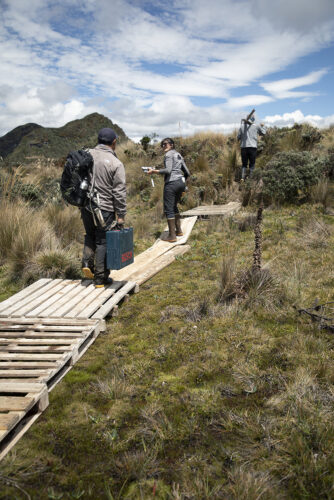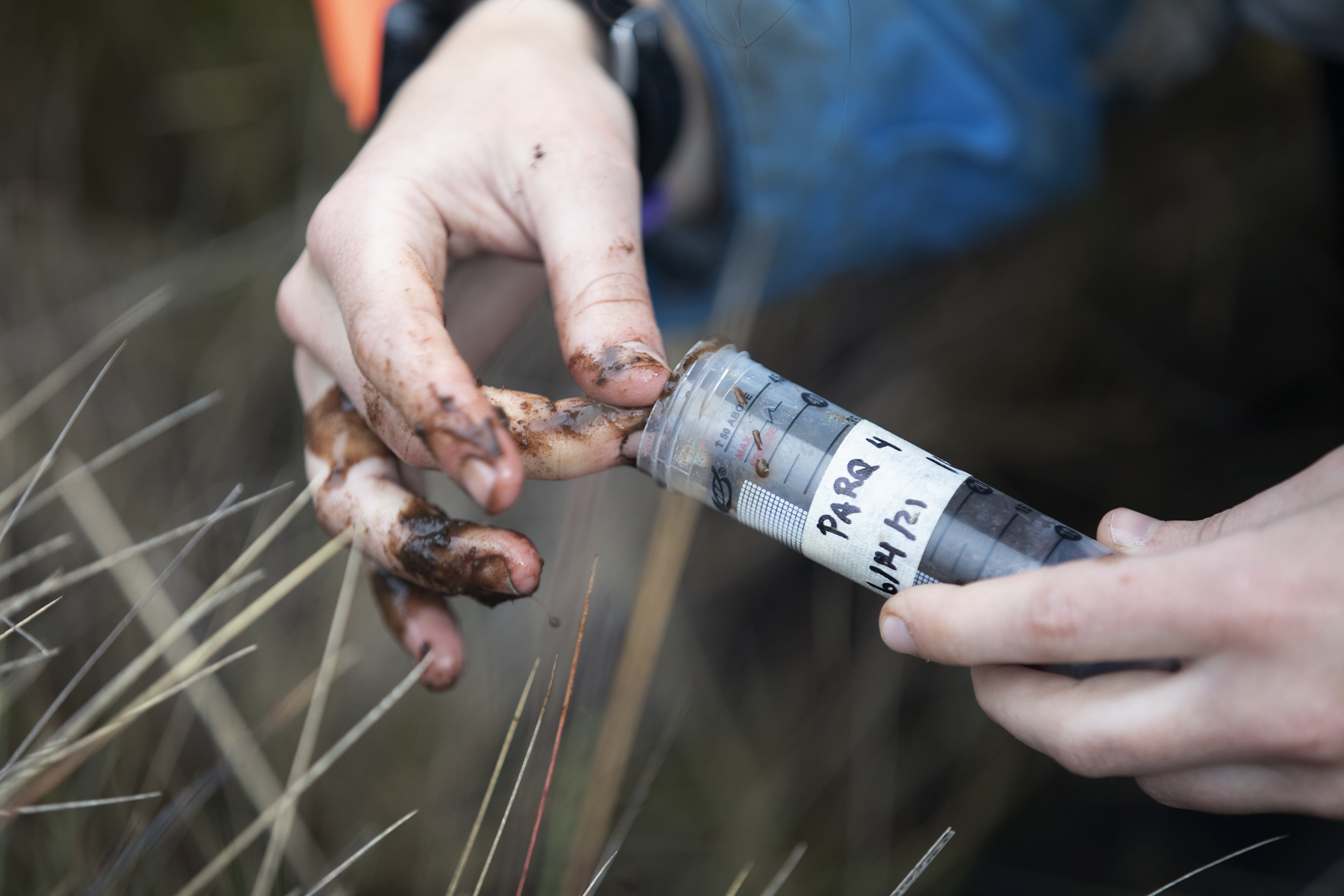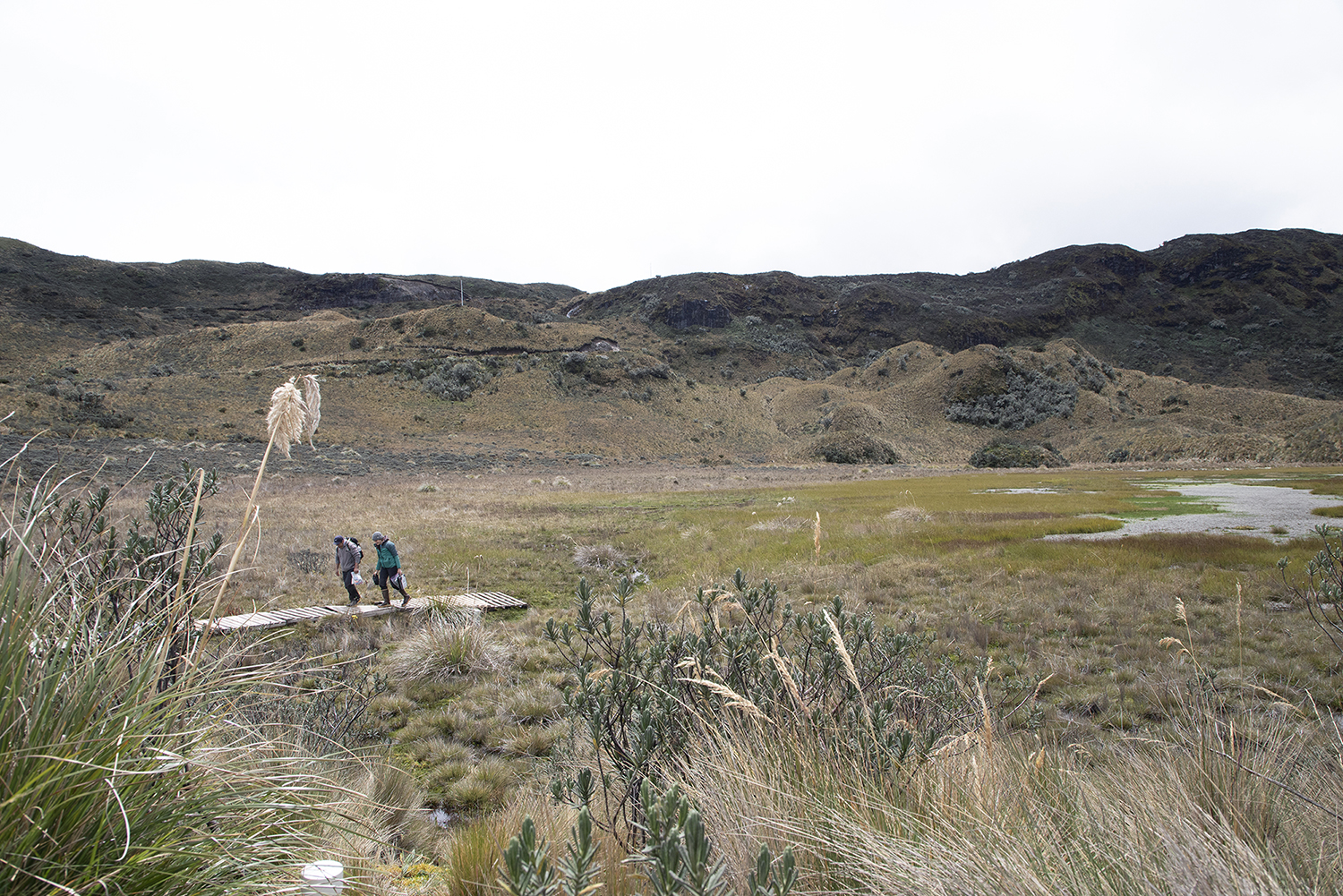Kriddie Whitmore paces back and forth in a small, brightly lit lab at the Universidad San Francisco de Quito (USFQ). She looks up at the glass-paned cabinets, scanning the contents of each one to assess what she’ll need for the day ahead. She pauses, holds her hand to her chin, and peers into the large black plastic tub sitting on the floor. She pulls out her phone to check the time. It’s already 7:30 a.m.
UNC-Chapel Hill geographer Diego Riveros-Iregui and USFQ ecologist Esteban Suárez Robalino stand nearby, patiently awaiting Whitmore’s instructions.
“Do I need the CO2 sensors?” she asks.
“You’re the boss,” Suárez Robalino says with a laugh. “You tell us.”
This propels Whitmore into action. She whips around and plops the black gear box onto the lab bench. She opens all of the cabinets and begins filling the box with an array of materials — plastic sample bottles, zip ties, a tool kit, batteries, wiring, a few yellow waterproof notebooks.
“Where’s the GPS?” she asks, while rifling through two nearby backpacks. “Ah-ha! Found it.”
She snaps on the lid and fills two more boxes. When she thinks she’s done, she puts her hands on her hips, nods her head, and tells Riveros-Iregui, Suárez Robalino, and her four lab techs to grab whatever they can carry and put it in the van. She makes one last 360-degree turn in the lab, throws a sledgehammer over her shoulder, and exits, locking the door behind her.
It is Tuesday, June 8. And today is the first field day of the second season of Riveros-Iregui’s project in the Ecuadorian páramo, an exotic and remote landscape in the northern Andes Mountains. More specifically, his project takes place in the Cayambe Coca Ecological Reserve, a national park located about 45 minutes outside of Quito, Ecuador. This region contains more carbon in the soil per unit area than almost any other ecosystem in the world — a huge draw for Riveros-Iregui, who studies how carbon travels through water, air, and land.
As the earth continues to warm, Riveros-Iregui thinks the carbon that’s normally preserved here because of colder weather will start to release, further heating the planet. He and his lab want to learn if this is true and, if so, the processes that occur for it to happen.
Whitmore, a UNC PhD student, has been working on the project since 2019, but this year she’s running it, which means managing all of the experiments and data collection, as well as four research technicians — two from USFQ and two former UNC students who began working in the Riveros-Iregui lab in Spring 2020. This is the largest team Whitmore has ever overseen.
“Being the boss is only hard when there’s people who don’t want to do what they have to do — and that’s not the case here at all,” she says. “Everybody on the team is excited about the work, and that’s like the best situation ever. And I don’t feel like a boss. I just feel like I’m giving suggestions.”
This is the norm for a PhD student working on a dissertation: the autonomy, the project oversight, the decision-making. But the unpredictable weather of the páramo, the limited resources for fixing equipment if it breaks, and the language barrier add a multitude of challenges.
Whitmore handles it all with enthusiasm, grace, and lots of ingenuity.

Whitmore talks to the driver about her plan for the first day in the field and the locations they will visit. (photo by Alyssa LaFaro)
Heading to the field
Upon exiting the lab, Whitmore and her seven-person team pile into a yellow passenger van to begin a 45-minute drive to the Cayambe Coca Ecological Reserve. After just 10 minutes, the bustling traffic of Cumbayá — a rural parish east of Quito where USFQ is located — begins to fade and the road climbs and curves. Yogurt sellers stand along the shoulder of the country highway and wave at passing cars, hopeful one will stop to purchase some of their milky wares.
The higher in altitude the van travels, the larger the tree-covered hills become and the grayer the sky turns. A soft mist fills the landscape, creating a comfortable silence. But inside the van, endless chatter abounds. Riveros-Iregui and Suárez Robalino converse in Spanish about how they think the next eight weeks will play out. In the back, Whitmore and Suárez Robalino’s techs — Segundo Chimbolema and Ricardo Jaramillo — discuss their various experiences in the field, switching back and forth between English and Spanish.
Research technicians Liz Farquhar and Tessa Davis, both of whom just wrapped their senior years at UNC, share how they can’t believe they are finally here. They were supposed to come to Ecuador the previous summer in 2020, but — like most things — the pandemic put a stopper on the project. Riveros-Iregui assigned them a different study to work on during their final year at UNC and, when it looked like a trip to Ecuador might be possible in 2021, he pushed for their attendance, offering to hire them on as research technicians after graduation. Both accepted the offer eagerly.
“It took a long time to get here,” Davis shares. “In fact, I didn’t let myself believe it was real until I was sitting on the plane, watching the Raleigh-Durham airport disappear into nothing.”
The time passes quickly, and the van slows upon entrance to the reserve. After making a hard, nearly 180-degree turn onto the park’s rocky road, the researchers grow quiet. They take in the landscape’s beautiful bleakness — the muted sky, the autumnal colors, the jagged hills.
A few minutes up the road, the van pulls over by the field site and Suárez Robalino opens the sliding door. Cold air greets exposed faces and hands. The researchers tug on knit hats and gloves. Some even don a second pair of socks.
Whitmore will do that later.
She clambers to the front of the van, jumps out, and runs to a nearby rock. She climbs upon it and stares at the site, slightly out of breath from the increased elevation. It’s been two years since she’s looked upon this watershed — and she can’t wait to begin.

Whitmore looks out over the field site. (photo by Alyssa LaFaro)
Tapping into local knowledge
During the 2019 field season, Riveros-Iregui’s students constructed and monitored a series of experiments to measure water flow, dissolved oxygen, and forms of carbon like carbon dioxide and methane. The goal of the 2021 field season is to restart the measurements that stopped because of the pandemic. Riveros-Iregui hopes to collect observations for an entire calendar year to gain knowledge about carbon outputs in the páramo during both the dry and wet seasons.
But collecting data for just a few months in the páramo is tricky. All the research monitoring stations require batteries that need to be checked and changed on a weekly basis, sensors could be swept away during thunderstorms, and a washed-out road could prevent access to a field site. Plus, replacing damaged equipment is either expensive or impossible in Ecuador, which imports most of its scientific instruments from other countries.
“You have to roll with the punches and try to make the best of the situation when a sensor stops working,” Whitmore says.
During the first week of the 2021 field season, Whitmore discovered that a few of the 2019 sensors had stopped recording data. This need for continuous monitoring means multiple researchers need to be involved — and that’s why Riveros-Iregui has partnered with Suárez Robalino.

After a few hours of setting up and testing sensors at the main wetland, Chimbolema, Whitmore, and Jaramillo carry equipment to the next field site. (photo by Alyssa LaFaro)
A terrestrial ecologist and Ecuadorian native, Suárez Robalino has invaluable local knowledge of the páramo and lab space on campus, both of which have been vital resources since the project began. This year, he’s involved Chimbolema and Jaramillo so that they can help monitor the stations after Whitmore and her team return to the states.
“Having this wide breadth of knowledge is incredibly useful because it takes years to accrue,” Whitmore says. “Segundo, for example, is enormously capable and confident, really knows what he’s doing, and has a ton of experience. And that is the most valuable person on the team, I think. Because they can really help you think about how things can be set up correctly and, when things go wrong, they have the experience to fix it.”
For Chimbolema and Jaramillo, both local to Ecuador, any research in the páramo is good research.
“To study the páramo and to provide knowledge about what the páramo gives us, not only in Quito but the whole country, is important because of water,” Chimbolema says. “If we do not preserve the páramo we are not going to have water.”
The páramo provides about 85 percent of all drinking water for Ecuador and is a source of the greater Amazon watershed. About 60 percent of the flora that grow there are endemic, meaning they aren’t found anywhere else on Earth. This landscape is not only threatened by the changing climate, but agricultural and industrial activities.
“It’s a really important ecosystem,” Whitmore stresses. “And it is an ecosystem that is being quickly converted to different land uses and is heavily used by people. Páramos are very difficult to reach and very difficult to study, so we don’t know what’s going on in them. We don’t understand how much carbon is coming off of these landscapes as carbon dioxide or methane. Understanding that is significant for the entire carbon cycle, for the global carbon cycle. That atmosphere is everybody’s atmosphere.”
Overcoming obstacles
The sun sits high overhead as Whitmore stands in a waist-deep trench and holds a piece of rebar as Jaramillo uses a sledgehammer to secure it in the ground. They’ve been at this for about five hours and have yet to break for lunch. On top of the rebar now in place, Whitmore attaches a gray box that contains a sensor for measuring carbon dioxide. Five of these monitoring stations are spread throughout the páramo.
Farquhar sits on the edge of the trench and watches a stream of water slosh around Whitmore’s boot-clad feet. It is one of many in the intricate web that is the local watershed. She snaps out of her reverie and looks back to the GPS unit in her hand, reporting the coordinates to Whitmore. This is the only way to keep track of the sensors, most of which remain invisible to the average observer thanks to the reserve’s carved-out canals and abundant foliage.
“The hydrology setup is unreal,” Davis says. “In our páramo, specifically, there are just pockets of wetland. You never know where a stream is going or coming from. That’s really cool to me.”

Davis collects a soil sample from the field. (photo by Alyssa LaFaro)
Within the first week of the project, Whitmore and her team deployed 20 sensors across the paramo, all of which require weekly monitoring. They also installed three solar panels to reduce battery usage. In just eight weeks, they experienced blinding fog, sleet, and snow — and even a rockslide that prevented the van from getting to one of the field sites. They walked eight miles to collect the data.
The demands of this kind of fieldwork invigorate Whitmore.
“I love being outside. I love a challenge and doing something that most people have never done,” Whitmore says. “I’m a really curious person, and I get bored easily. In the field, there’s always something to see and think and wonder about.”
The Ecuador project is far from over. Since returning to Chapel Hill in late July, Whitmore has continued to monitor the project from afar through regular check-ins with her USFQ counterparts. In the lab at UNC, she’s busy analyzing water and methane samples collected in the field and logging data from the carbon dioxide sensors.

Chimbolema and Whitmore leave the field site after a productive day of inserting and testing sensors. (photo by Alyssa LaFaro)
Whitmore will return to the field later this year to check the sensors, change out the batteries, and troubleshoot any other problems that may have arisen since August. In 2022, she will bring a different group of students to the field to collect another round of measurements for her dissertation.
“This experience offers me the chance to build my confidence as a project leader,” Whitmore shares. “And it reaffirms that I really love this subject, and I love working with people on this topic. Working with people who are also excited about these things and getting to talk to them about it is a beautiful thing. It’s wonderful.”

